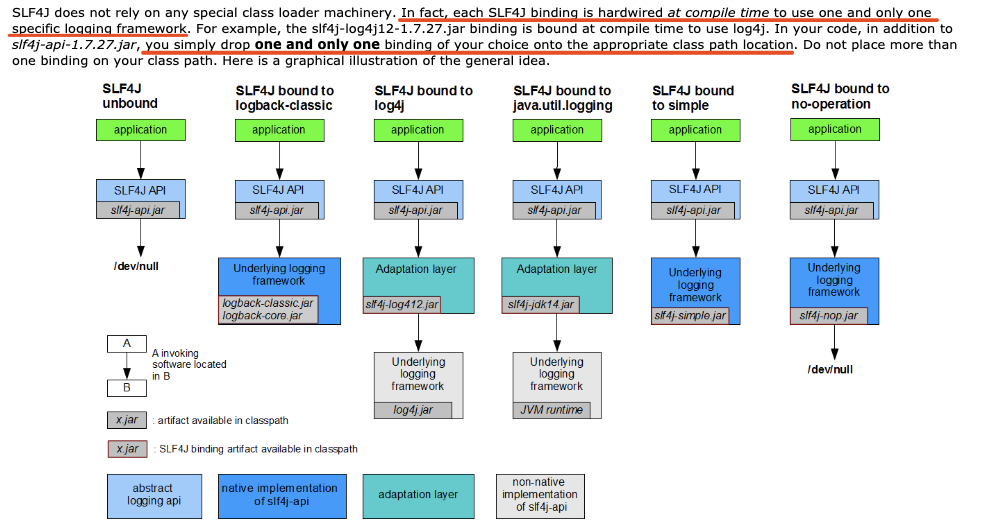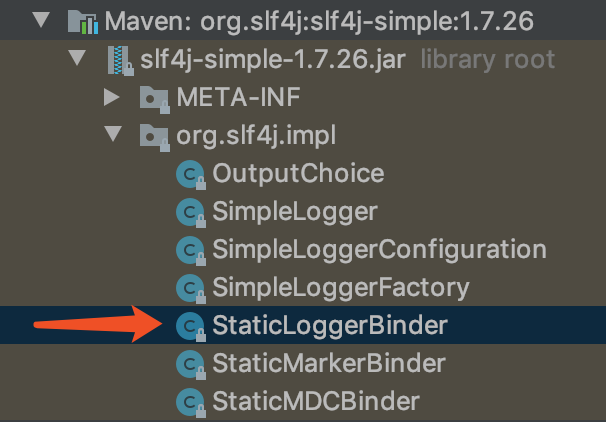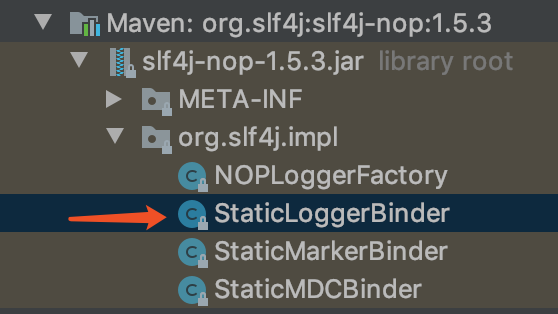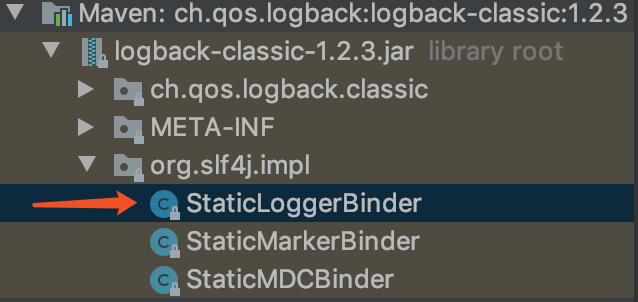源码解读SLF4J绑定日志实现的原理
一、导读
我们使用log4j框架时,经常会用slf4j-api。在运行时,经常会遇到如下的错误提示:
SLF4J: Class path contains multiple SLF4J bindings. SLF4J: Found binding in [jar:file:/Users/abc/maven-repository/org/slf4j/slf4j-simple/1.7.26/slf4j-simple-1.7.26.jar!/org/slf4j/impl/StaticLoggerBinder.class] SLF4J: Found binding in [jar:file:/Users/abc/maven-repository/org/apache/logging/log4j/log4j-slf4j-impl/2.7/log4j-slf4j-impl-2.7.jar!/org/slf4j/impl/StaticLoggerBinder.class] SLF4J: See http://www.slf4j.org/codes.html#multiple_bindings for an explanation. SLF4J: Actual binding is of type [org.slf4j.impl.SimpleLoggerFactory]
也即classpath下有多个日志实现,slf4j-api在绑定时出现了冲突。那么这时slf4j-api到底会绑定哪一个具体的实现呢?
官方文档有如下说明:


也就是说,当有多个日志实现时,SLF4J会在编译期随机选择其中的一个实现。那么,它到底是如何随机选择的呢?下面我们通过源码来分析。
请尊重作者劳动成果,转载请标明原文链接:https://www.cnblogs.com/waterystone/p/11329645.html
二、源码分析
2.1 LoggerFactory.getLogger(this.getClass())
我们通过LoggerFactory.getLogger(this.getClass())拿到Logger对象,其代码如下:
public static Logger getLogger(Class<?> clazz) {
Logger logger = getLogger(clazz.getName());
if (DETECT_LOGGER_NAME_MISMATCH) {
Class<?> autoComputedCallingClass = Util.getCallingClass();
if (autoComputedCallingClass != null && nonMatchingClasses(clazz, autoComputedCallingClass)) {
Util.report(String.format("Detected logger name mismatch. Given name: \"%s\"; computed name: \"%s\".", logger.getName(),
autoComputedCallingClass.getName()));
Util.report("See " + LOGGER_NAME_MISMATCH_URL + " for an explanation");
}
}
return logger;
}
2.2 LoggerFactory.bind()
getLogger() -> getILoggerFactory()-> performInitialization() -> bind() ,bind()即绑定日志实现的函数,其源码如下:
private final static void bind() {
try {
Set<URL> staticLoggerBinderPathSet = null;
// skip check under android, see also
// http://jira.qos.ch/browse/SLF4J-328
if (!isAndroid()) {
staticLoggerBinderPathSet = findPossibleStaticLoggerBinderPathSet(); //在classpath下查找有多少个日志实现
reportMultipleBindingAmbiguity(staticLoggerBinderPathSet); //如果有多个日志实现,打印出来
}
// the next line does the binding。classpath下每个日志实现jar都会有org.slf4j.impl.StaticLoggerBinder类,这里会随机加载其中的一个。
StaticLoggerBinder.getSingleton();
INITIALIZATION_STATE = SUCCESSFUL_INITIALIZATION;
reportActualBinding(staticLoggerBinderPathSet);
fixSubstituteLoggers();
replayEvents();
// release all resources in SUBST_FACTORY
SUBST_FACTORY.clear();
} catch (NoClassDefFoundError ncde) { //如果在classpath下没有找到一个org.slf4j.impl.StaticLoggerBinder
String msg = ncde.getMessage();
if (messageContainsOrgSlf4jImplStaticLoggerBinder(msg)) {
INITIALIZATION_STATE = NOP_FALLBACK_INITIALIZATION;
Util.report("Failed to load class \"org.slf4j.impl.StaticLoggerBinder\".");
Util.report("Defaulting to no-operation (NOP) logger implementation");
Util.report("See " + NO_STATICLOGGERBINDER_URL + " for further details.");
} else {
failedBinding(ncde);
throw ncde;
}
} catch (java.lang.NoSuchMethodError nsme) {
String msg = nsme.getMessage();
if (msg != null && msg.contains("org.slf4j.impl.StaticLoggerBinder.getSingleton()")) {
INITIALIZATION_STATE = FAILED_INITIALIZATION;
Util.report("slf4j-api 1.6.x (or later) is incompatible with this binding.");
Util.report("Your binding is version 1.5.5 or earlier.");
Util.report("Upgrade your binding to version 1.6.x.");
}
throw nsme;
} catch (Exception e) {
failedBinding(e);
throw new IllegalStateException("Unexpected initialization failure", e);
}
}
2.3 LoggerFactory.findPossibleStaticLoggerBinderPathSet()
接下来,我们再看看findPossibleStaticLoggerBinderPathSet()如何在classpath下查找有多少个日志实现的源码:
static Set<URL> findPossibleStaticLoggerBinderPathSet() {
// use Set instead of list in order to deal with bug #138
// LinkedHashSet appropriate here because it preserves insertion order
// during iteration
Set<URL> staticLoggerBinderPathSet = new LinkedHashSet<URL>();
try {
ClassLoader loggerFactoryClassLoader = LoggerFactory.class.getClassLoader();
Enumeration<URL> paths;
if (loggerFactoryClassLoader == null) { //用ClassLoader去查找classpath下有多少个org.slf4j.impl.StaticLoggerBinder类
paths = ClassLoader.getSystemResources(STATIC_LOGGER_BINDER_PATH);
} else {
paths = loggerFactoryClassLoader.getResources(STATIC_LOGGER_BINDER_PATH);
}
while (paths.hasMoreElements()) {
URL path = paths.nextElement();
staticLoggerBinderPathSet.add(path);
}
} catch (IOException ioe) {
Util.report("Error getting resources from path", ioe);
}
return staticLoggerBinderPathSet;
}
通过源码我们可以看到,findPossibleStaticLoggerBinderPathSet()会用ClassLoader查找当前classpath下有多少个org.slf4j.impl.StaticLoggerBinder类,每个path的URL能定位到其具体jar包位置。每个日志实现jar包都会有个org.slf4j.impl.StaticLoggerBinder类,反过来,那么classpath下有多少个StaticLoggerBinder类,就会有多少个相应的jar包,也即有多少个日志实现。所以findPossibleStaticLoggerBinderPathSet()通过扫描classpath下的org.slf4j.impl.StaticLoggerBinder类就能找到有多少个日志实现。
接下来,我们再看看是不是每个日志实现jar包都会有个org.slf4j.impl.StaticLoggerBinder类呢?答案是YES。
三、具体日志实现
3.1 slf4j-simple

3.2 slf4j-nop

3.3 logback-classic

3.4 log4j-slf4j-impl

四、总结
- 每个日志实现jar都会有org.slf4j.impl.StaticLoggerBinder类的实现;
- SLF4J会通过ClassLoad扫描当前classpath下有多少个org.slf4j.impl.StaticLoggerBinder类,也就找到了有多少个日志实现(通过这样,我们只需在项目中加入日志实现的jar包,编译时即可自动加载,业务代码无须显式依赖,实现解耦);
- 如果有多个org.slf4j.impl.StaticLoggerBinder类,SLF4J会在LoggerFactory.bind()里调用StaticLoggerBinder.getSingleton()随机加载一个日志实现jar的StaticLoggerBinder。
- 发现一个有趣的现象,在本地idea上运行时,是加载pom.xml里声明的第一个日志实现;但是如果打包好后通过java -jar启动时,其加载的日志实现确实是随机的(是在编译打包时随机加载一个日志实现,所以一旦编译打包好后其加载的那个日志实现就会固定不变)。所以,我们在具体使用时一定要通过排除依赖的方式来确定日志实现,不要由于日志实现的不确定性引入难以排查、不必要的坑。
- 作者:水岩
- 出处:http://www.cnblogs.com/waterystone
- 本博客中未标明转载的文章归作者水岩和博客园共有,欢迎转载,但未经作者同意必须保留此段声明,且在文章页面明显位置给出原文连接,否则保留追究法律责任的权利。
如果您觉得本文对您的学习有所帮助,可通过支付宝(左) 或者 微信(右) 来打赏博主,增加博主的写作动力





